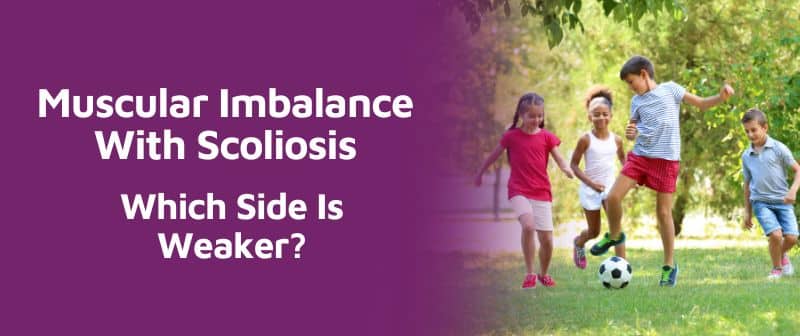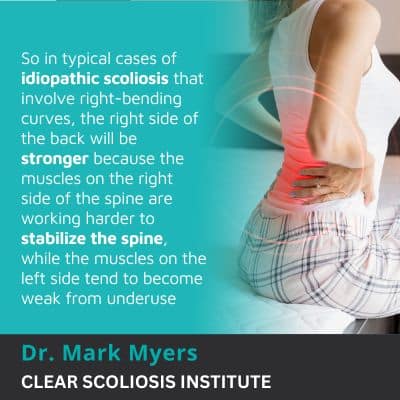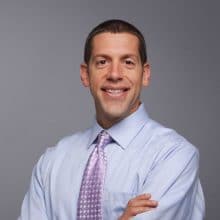
Although scoliosis is a spinal condition, it doesn’t just affect the back; it also impacts the spine’s surrounding nerves, muscles, and the rest of the body. Continue reading to learn how an unnatural spinal curve can cause a muscular imbalance and what can be done about it.
The uneven forces of scoliosis disrupt the spine’s alignment and the body’s natural symmetry, including back muscles. When a scoliotic curve bends to the right, the muscles on the right side of the spine are being overused, while muscles on the opposite side are being underused.
Before getting to the specifics of how a scoliosis-related muscular imbalance develops, let’s define the condition and explore its main effects.
While each case of scoliosis is unique and what one patient experiences doesn’t always indicate what others will face, there are some common condition effects that many patients experience.
A large degree of spinal health and function is determined by the spine’s alignment and curves; a healthy spine has its vertebrae aligned and its healthy and natural curves in place.
If the spine loses one or more of its healthy curves, they are replaced by unhealthy curves, and this disrupts the biomechanics of the entire spine, not just the spinal section with the scoliotic curve.
Scoliosis is the development of an unnatural sideways-bending spinal curve that also twists, and the rotation is what makes scoliosis a 3-dimensional condition.

When it comes to understanding scoliosis effects, I like to divide this topic into two categories: childhood scoliosis and adult scoliosis.
When it comes to understanding the effects of scoliosis, it’s crucial that patients understand that as a progressive condition, the nature of scoliosis is to get worse, so virtually all cases will at some point.
Scoliosis being progressive means that where a person’s condition is when it’s first diagnosed doesn’t indicate that’s where it will stay; scoliosis ranges widely in severity from mild to severe scoliosis.
Scoliosis affects all ages but is most commonly diagnosed in children, and the main condition effect in children is postural deviation, which becomes more overt as progression occurs.
Scoliosis progressing means the size of the unnatural spinal curve is increasing, and only proactive treatment can help counteract the condition’s nature.
In many cases of childhood scoliosis, the condition’s early telltale signs are uneven shoulders and hips.
Additional condition effects can include:
Additional effects include clothing hanging on the body unevenly (neck lines pulling to one side), and disruptions to a person’s balance, coordination, and gait.
Now, as the main effect of scoliosis in adults is different, before discussing muscles, let’s first touch on why and how scoliosis affects adults differently.
Scoliosis will also cause postural changes in adults, particularly a noticeable lean to one side that’s most overt when bending forward.
Difficulty standing for long periods of time is common, along with changes to how a person walks and balances.
The main condition effect in adults, however, is pain, and this is because scoliosis becomes a compressive condition once skeletal maturity has been reached, and it’s compression (uneven forces) being exposed to the spine and its surrounding muscles and nerves that’s the main source of condition-related pain.
In fact, it’s most often pain that brings adults in for a diagnosis and treatment, and the lack of pain in childhood scoliosis is a barrier to early detection.
Scoliosis pain caused by compression can include back pain, pain that radiates into the extremities due to nerve involvement, and muscle pain.
Let’s now address how and why scoliosis affects the spine’s surrounding muscles.
We know that scoliosis causes a disruption to the body’s natural symmetry as the condition causes a shift in the body’s center of gravity.
We also know that scoliosis doesn’t just affect the spine, but also the spine’s surrounding muscles, because it’s not just the spine that has to maintain its natural and healthy curves; it’s also the role of the spine’s supportive muscles to stabilize the spine.
In fact, although it remains one of many theories regarding the etiology of idiopathic scoliosis, there was a time when weak back muscles were considered as a potential cause for the spine’s inability to maintain its healthy curves and alignment.
In most cases of typical scoliosis, we don’t know what causes its initial onset, but we know that it’s growth that triggers it to progress, hence why scoliosis in children should be taken so seriously.
The majority of scoliosis cases are considered idiopathic (approximately 80 percent), so these are typical cases, but there are also atypical cases of scoliosis that are associated with known causes, and these types include neuromuscular scoliosis, congenital scoliosis, and degenerative scoliosis.
When an unnatural spinal curve develops, it’s pulling the spine’s surrounding muscles in different directions; muscles on one side of the curve will have to work harder to counteract the curve’s development and progression, while muscles on the other side can become weak from underuse.
Which side of the back is weaker will depend on the curvature type: dextroscoliosis (curves to the right) versus levoscoliosis (curves to the left).
In typical cases of idiopathic scoliosis, the curve bends unnaturally to the right, away from the heart, but in atypical scoliosis cases, the curve can bend towards the heart, to the left.

For example, in cases of neuromuscular scoliosis, the scoliosis develops as a secondary complication of a larger neuromuscular condition such as cerebral palsy, spina bifida, and muscular dystrophy.
Dextroscoliosis involves typical curves that bend to the right, while levoscoliosis involves atypical curves bending to the left.
So in typical cases of idiopathic scoliosis that involve right-bending curves, the right side of the back will be stronger because the muscles on the right side of the spine are working harder to stabilize the spine, while the muscles on the left side tend to become weak from underuse.
Muscles that have to work excessively to counteract the condition’s uneven forces can become stretched due to overuse, and muscles that are underused become smaller, weaker, and tighter over time.
Both over- and under-used muscles are problematic, which is why a focus of conservative scoliosis treatment is on improving the health and strength of the spine’s surrounding muscles.
When it comes to scoliosis, as a progressive condition, its effects are likely to become more noticeable over time, and this includes how the condition impacts the spine’s surrounding muscles.
The muscles of the back are important, not just because they stabilize and support the spine; they also support the torso and are involved in how the neck, head, shoulders, arms, and legs move.
The muscles of the lumbar spine (lower back), in particular, work together to facilitate a wide range of motion such as twisting, bending, and lifting motions.
A scoliotic curve bends unnaturally to the side and also twists, and scoliotic curves can be typical and bend to the right, or atypical and bend to the left.
So in typical cases of idiopathic scoliosis that feature right-bending curves, the right side of the back is going to be stronger because the muscles on the right side of the spine are working harder to counteract the unnatural pull of the spine, and muscles on the left side of the spine become weaker and loose from underuse.
When the spine’s surrounding muscles are imbalanced, this can cause pain, muscle spasms, impact movement, and if left unaddressed, a muscular imbalance can lead to muscle atrophy (the wasting away of muscle tissue due to lack of use).
As a CLEAR-certified scoliosis chiropractor, I treat scoliosis with a conservative treatment approach that involves scoliosis-specific chiropractic care, physical therapy and the prescription of scoliosis-specific exercises.
Physical therapy and scoliosis-specific exercises can help by increasing back-muscle strength, flexibility, and can focus on strengthening weak back muscles, and tightening stretched and strained over-used muscles.
The goal of conservative scoliosis treatment is to adjust the position of the curve’s most-tilted vertebral bodies to impact the condition’s underlying structural nature, and scoliosis-specific physical therapy and exercise is applied to strengthen the spine’s surrounding muscles and address any related muscular imbalance so the condition’s asymmetrical effects are managed and minimized.

CLEAR provides a unique and innovative way of understanding scoliosis. Sign up to receive facts and information you won’t find anywhere else.

When you say right or left bending side, I don't understand that. I do know that my left side is the concave side. So is the weak side the concave side? I would think so as that's the side with some atrophy. Please advise. Thanks so much.
Hello,
I am unsure what you may be referring to. If you are wanting to know specific exercises that may help your scoliosis, there are many exercise do's and don't depending on your unique scoliosis and circumstances. Each person's scoliosis is different and something that would be fine for one person would be contraindicated for another person. Our CLEAR Scoliosis Institute certified Doctors specialize in treating each individual based on their spinal curvature, age, amount of degeneration, risk of progression, etc. I recommend contacting the CLEAR Scoliosis Doctor nearest you for a consultation and to formulate a specific at-home exercise program that would help target your problem areas and provide you with what is and is not good for your spinal curvature. To find the nearest clinic, please visit our website under Find a Doctor. Best of luck. Please let us know if we can be of further assistance.